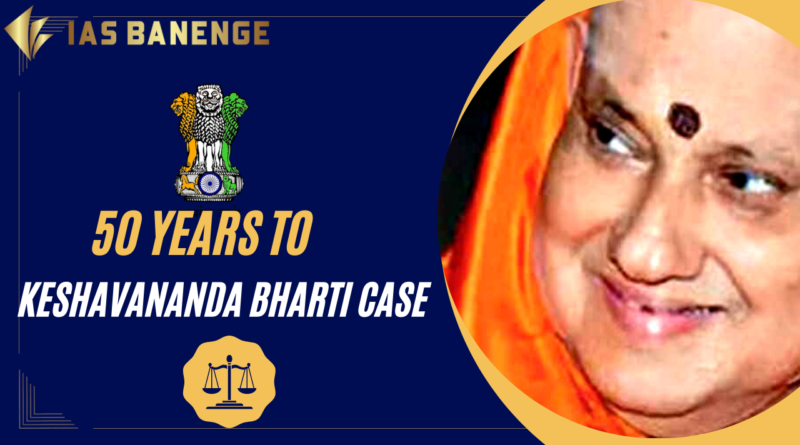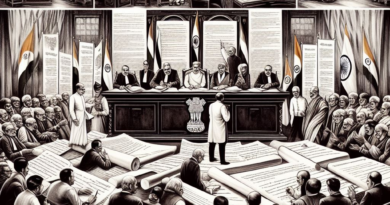“The Keshavananda Bharti Case at 50: Celebrating the Foundation of India’s Constitutional Democracy”- IAS Banenge
Keshavananda Bharti v. State of Kerala, popularly known as the Fundamental Rights case, is considered one of the most significant cases in Indian constitutional law history. The case was heard by a 13-judge bench of the Supreme Court of India, headed by Chief Justice S. M. Sikri, from October 31, 1972, to March 23, 1973. This case is known for the doctrine of basic structure, which holds that certain parts of the Constitution are so fundamental that they cannot be amended by the Parliament, even if the amendment is in compliance with the provisions of the Constitution.
Background
In 1967, the Communist Party of India (Marxist) (CPI(M)) formed the first democratically elected government in the southern state of Kerala. The CPI(M) government passed a series of land reform laws, which aimed to limit the maximum amount of land that a person could hold and to redistribute land to the landless. Keshavananda Bharti, the head of the Edneer Mutt in Kasaragod district, challenged the Kerala government’s land reform laws, claiming that they violated his fundamental rights to hold and dispose of property.
The case was first heard by a five-judge bench of the Supreme Court in 1971, which upheld the validity of the Kerala land reform laws. However, the bench also stated that the Parliament had the power to amend the Constitution and that there were no limitations on the Parliament’s amending power.
Keshavananda Bharti filed a review petition against the judgment of the five-judge bench, which was then referred to a larger bench of the Supreme Court. The Chief Justice of India, S. M. Sikri, constituted a 13-judge bench to hear the case.
Arguments
The main argument put forth by Keshavananda Bharti was that the Constitution’s basic structure should be protected from any amendments by the Parliament. He argued that the Constitution’s basic structure comprised certain fundamental rights, the principles of democracy, the separation of powers, and the federal character of the Constitution. According to him, any amendment that violated these fundamental features of the Constitution should be held invalid.
The Attorney General of India, Niren De, argued that the Parliament had the power to amend any part of the Constitution, including the fundamental rights, and that there were no limitations on the Parliament’s amending power.
READ MORE – ISRO To Prioritise R&D |Ias Banenge
Judgment
On April 24, 1973, the Supreme Court delivered its judgment in the Keshavananda Bharti case. The 13-judge bench held that the Parliament had the power to amend the Constitution but subject to certain limitations. The bench declared that the basic structure of the Constitution could not be amended, and any amendment that violated the Constitution’s basic structure would be held invalid.
The bench did not define the Constitution’s basic structure but listed some of the fundamental features of the Constitution that could not be amended. These features included the supremacy of the Constitution, the rule of law, the separation of powers, the federal character of the Constitution, and the fundamental rights.
The judgment was not unanimous, and six of the 13 judges delivered dissenting opinions. The dissenting judges argued that the Constitution’s basic structure was not well defined, and the doctrine of basic structure could be misused to strike down any constitutional amendment. They also expressed concern that the judiciary’s power to interpret the Constitution had been increased, and the Parliament’s power to amend the Constitution had been curtailed.
Impact
The Keshavananda Bharti case is considered a landmark judgment in Indian constitutional law history. The doctrine of basic structure, as propounded in this case, has been used in several subsequent cases to strike down constitutional amendments. For example, in the Minerva Mills case (1980), the Supreme Court struck down certain provisions of the Constitution (42nd Amendment) that sought to dilute the powers of judicial review and curtail fundamental rights.
The doctrine of basic structure has also been used to protect the federal character of the Constitution. In the S.R. Bommai case (1994), the Supreme Court held that the basic structure of the Constitution included federalism and that any attempt to undermine federalism would be struck down.
The Keshavananda Bharti case has also been influential in shaping the relationship between the judiciary and the Parliament. The judgment established the supremacy of the Constitution and the rule of law over the Parliament’s power to amend the Constitution. It also recognized the judiciary’s role in interpreting the Constitution and upholding its basic structure.
However, the Keshavananda Bharti case has also been criticized for giving too much power to the judiciary and undermining the Parliament’s power to amend the Constitution. Some argue that the doctrine of basic structure has been used to create a “super-constitution” that places the judiciary above the elected representatives of the people.
Conclusion
The Keshavananda Bharti case is a significant milestone in Indian constitutional law history. It established the doctrine of basic structure and placed certain fundamental features of the Constitution beyond the Parliament’s power to amend. The judgment has had far-reaching implications for Indian democracy, protecting the federal character of the Constitution and upholding the supremacy of the Constitution and the rule of law. However, it has also been criticized for creating a “super-constitution” that places the judiciary above the Parliament. The impact of the Keshavananda Bharti case on Indian constitutional law will continue to be felt for many years to come.





Pingback: Zero Shadow Day In Bangaluru-Ias Banenge - Ias Banenge